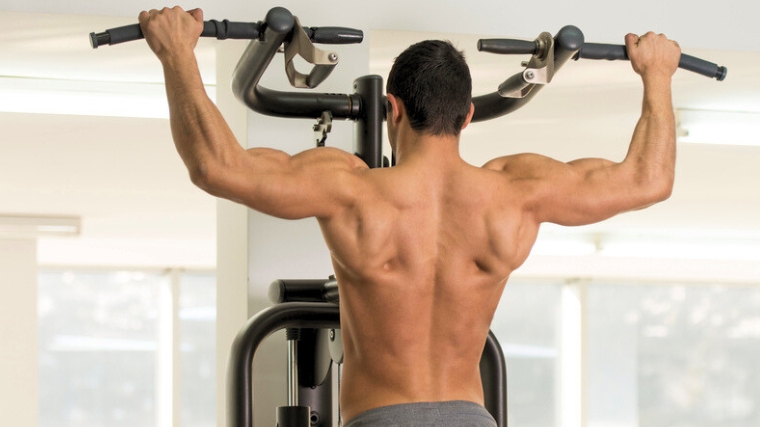Have you ever wondered which exercise is better for building a strong and defined back: dumbbell rows or pull-ups? Well, you’re not alone! Many people are torn between these two exercises and unsure of which one to prioritize in their workouts.
In this article, we’re going to dive into the ultimate back exercise battle and analyze the benefits and drawbacks of both dumbbell rows and pull-ups. Whether you’re a beginner looking to start incorporating back exercises into your routine or a seasoned gym-goer wanting to switch things up, this article will provide you with all the information you need to make an informed decision.
When it comes to building a strong and muscular back, dumbbell rows and pull-ups are two of the most effective exercises.
Dumbbell rows primarily target the muscles in your upper back, such as the latissimus dorsi and rhomboids, while pull-ups engage a wider range of muscles including the lats, biceps, and even the core. Both exercises have their advantages and can help you achieve a stronger and more defined back, but the right choice depends on your fitness level and personal goals.
In this article, we’ll delve deeper into the mechanics of each exercise, the muscles they target, and the variations and progressions you can incorporate to continually challenge yourself and see progress.
So, whether you prefer the simplicity of dumbbell rows or the challenge of pull-ups, stay tuned to learn more about these two back exercise powerhouses!

Overview of Dumbbell Rows
Dumbbell rows are a classic back exercise that primarily target the muscles of the upper back, including the lats, rhomboids, and traps. To perform a dumbbell row, start by placing one knee and hand on a bench for support, while holding a dumbbell in your opposite hand. Keep your back straight and core engaged as you row the dumbbell towards your hip, squeezing your shoulder blade at the top of the movement. Dumbbell rows can be performed with one arm at a time or with both arms simultaneously.
Benefits of Dumbbell Rows
Dumbbell rows offer several benefits for your back muscles. Firstly, they help to develop overall back strength, which is important for maintaining good posture and preventing injury. Additionally, dumbbell rows help to improve back muscle imbalances by strengthening the weak side of your back.
This can help prevent shoulder and back injuries caused by muscle imbalances. Lastly, dumbbell rows also engage muscles in the arms, shoulders, and core, making them a great compound exercise for overall upper body strength.
Muscles Targeted in Dumbbell Rows
Dumbbell rows primarily target the latissimus dorsi (lats), which are the large muscles that give your back a wide and strong appearance. They also engage the muscles of the upper back, including the rhomboids and trapezius, which help stabilize and support the spine. Additionally, the biceps, forearms, and core muscles are also involved in the execution of the exercise, making it a great option for overall upper body development.
Proper Form and Technique for Dumbbell Rows
To get the most out of your dumbbell row exercise, it’s important to maintain proper form and technique. Start by selecting an appropriate weight dumbbell that allows you to complete the exercise with good form while still challenging your muscles. Place one knee and hand on a bench, keeping your back straight and core engaged.
Begin the exercise by pulling the dumbbell towards your hip, imagining that you are squeezing a lemon between your shoulder blade. Control the movement on the way down, and avoid using excessive momentum or swinging to lift the weight. Repeat for the desired number of repetitions on each side.

Overview of Pull-Ups
Pull-ups are a challenging bodyweight exercise that primarily targets the muscles of the back, including the lats, rhomboids, and traps. In addition to the back, pull-ups also engage the muscles of the arms, shoulders, and core. To perform a pull-up, hang from a pull-up bar with your palms facing away from you, then pull yourself up until your chin is over the bar, and lower yourself back down with control.
Benefits of Pull-Ups
Pull-ups offer a variety of benefits for your back muscles. Firstly, they are a compound exercise that targets multiple muscles at once, resulting in efficient and effective workouts. Pull-ups help to develop upper body strength and power, as well as improve grip strength. Additionally, pull-ups are a functional exercise that mimics real-world movements, such as climbing or pulling yourself up over an obstacle. This makes them a great exercise for overall functional fitness and athleticism.
Muscles Targeted in Pull-Ups
Pull-ups primarily target the latissimus dorsi (lats), which are responsible for the wide and strong appearance of the back. They also engage the muscles of the upper back, including the rhomboids and traps, which help stabilize and support the spine during the exercise. Furthermore, pull-ups engage the muscles of the arms, particularly the biceps and forearms, as well as the muscles of the shoulders and core.
Different Variations of Pull-Ups
There are several variations of pull-ups that can be performed to target specific muscles or to add variety to your workouts. Some common variations include wide-grip pull-ups, which target the outer portion of the lats, close-grip pull-ups, which target the inner portion of the lats, and chin-ups, which target the biceps and upper back more than traditional pull-ups. Additionally, you can also use resistance bands or assistive machines to make pull-ups easier for beginners or those who need assistance.
Comparison of Dumbbell Rows and Pull-Ups
Now that we have covered the basics of dumbbell rows and pull-ups, let’s compare the two exercises in terms of their effectiveness in building back muscles, activation of different muscle groups, overall strength and endurance, and variety and progression.
Effectiveness in Building Back Muscles
Both dumbbell rows and pull-ups are highly effective in building back muscles, particularly the lats. However, dumbbell rows allow for a greater range of motion and can be loaded with heavier weights, which can lead to greater strength and muscle gains. Pull-ups, on the other hand, are a bodyweight exercise that require you to lift your entire body weight, making them a more challenging exercise for building back muscles.
Activation of Different Muscle Groups
While both exercises primarily target the muscles of the back, they also engage other muscle groups to varying degrees. Dumbbell rows engage the biceps, forearms, and core to a greater extent, while pull-ups engage the muscles of the arms, shoulders, and core more intensely. Therefore, if you are looking for a more comprehensive upper body workout, pull-ups may be the better choice.
Overall Strength and Endurance
Pull-ups are known for their ability to challenge both strength and endurance. They require you to lift your entire body weight, which can be a significant challenge for beginners or those who are not yet at an advanced fitness level. Dumbbell rows, on the other hand, can be adjusted to suit your current strength level by selecting an appropriate weight dumbbell. Therefore, if you are looking to build overall upper body strength and endurance, pull-ups may be the better choice.
Variety and Progression
Both dumbbell rows and pull-ups offer a variety of variations and progressions that can be used to keep your workouts challenging and to continue making progress. Dumbbell rows can be performed with one arm at a time or with both arms simultaneously, and the weight can be increased as you get stronger.
Pull-ups can be performed with different grips and hand positions, such as wide grip, close grip, or underhand grip. You can also add weight to pull-ups by using a weight belt or holding a dumbbell between your feet. Therefore, both exercises offer plenty of variety and opportunities for progression.

Factors to Consider When Choosing Between Dumbbell Rows and Pull-Ups
When it comes to choosing between dumbbell rows and pull-ups, there are several factors to consider, including the availability of equipment, your individual fitness level, pre-existing injuries or limitations, and personal preference and goals.
Availability of Equipment
Dumbbell rows can be performed with just a pair of dumbbells and a bench, making them a great option for those who prefer to workout at home or have limited access to a gym. Pull-ups, on the other hand, require a pull-up bar or a similar structure to hang from. Therefore, if you don’t have access to a pull-up bar, or if you prefer to workout at home with minimal equipment, dumbbell rows may be the better choice for you.
Individual Fitness Level
Pull-ups are a challenging exercise that require a certain level of strength and fitness. If you are a beginner or are not yet able to perform a full pull-up, you may need to start with an assisted variation or work on building strength with other exercises, such as lat pulldowns or inverted rows, before attempting full pull-ups. Dumbbell rows, on the other hand, can be adjusted to suit your current fitness level by selecting an appropriate weight dumbbell.
Pre-existing Injuries or Limitations
If you have any pre-existing injuries or limitations that prevent you from performing pull-ups or dumbbell rows with proper form, it’s important to take these into consideration when choosing your exercise. For example, if you have a shoulder injury that makes it difficult to perform pull-ups, dumbbell rows may be a safer and more suitable option.
Personal Preference and Goals
Ultimately, personal preference and your specific goals should play a role in determining whether dumbbell rows or pull-ups are the better choice for you. If you enjoy the challenge of lifting your own body weight and want to improve your overall upper body strength, pull-ups may be the better option. If you prefer to workout at home or have limited access to a gym, or if you want to focus on building specific muscles in your back using heavier weights, dumbbell rows may be the better choice.
How to Incorporate Dumbbell Rows and Pull-Ups in Your Back Workout
Now that you have a good understanding of the benefits and differences between dumbbell rows and pull-ups, let’s talk about how you can incorporate these exercises into your back workout routine.
Sample Dumbbell Row Workout
- Dumbbell Rows: 3 sets of 8-12 repetitions per arm, with a heavy weight that challenges your muscles. Rest for 60-90 seconds between sets.
- Wide-Grip Lat Pulldowns: 3 sets of 10-15 repetitions, with a weight that challenges your muscles. Rest for 60-90 seconds between sets.
- Seated Cable Rows: 3 sets of 10-12 repetitions, with a weight that challenges your muscles. Rest for 60-90 seconds between sets.
- Reverse Flyes: 3 sets of 12-15 repetitions, with a weight that challenges your muscles. Rest for 60-90 seconds between sets.
Sample Pull-Up Workout
- Pull-Ups: 3 sets to failure, using a grip and hand position that challenges your muscles. Rest for 60-90 seconds between sets.
- Assisted Pull-Ups or Lat Pulldowns: 3 sets of 10-12 repetitions, with a weight or assistance that challenges your muscles. Rest for 60-90 seconds between sets.
- Inverted Rows: 3 sets of 10-12 repetitions, with a weight or assistance that challenges your muscles. Rest for 60-90 seconds between sets.
- Banded Face Pulls: 3 sets of 12-15 repetitions, with a resistance band that challenges your muscles. Rest for 60-90 seconds between sets.
Combining the Exercises for Maximum Results
To maximize your back muscle development, you can combine both dumbbell rows and pull-ups in your workouts. For example, you can perform dumbbell rows as your primary exercise for heavy strength work, and then follow up with pull-ups or lat pulldowns for higher-rep, hypertrophy-focused work. Alternatively, you can alternate between dumbbell rows and pull-ups in your workouts, performing one exercise on one day and the other exercise on the next workout day.

Tips for Proper Execution and Avoiding Common Mistakes
When performing dumbbell rows or pull-ups, it’s important to maintain proper form and technique to avoid injuries and achieve the best results. Here are some tips to help you perform these exercises correctly:
Maintaining Proper Form and Technique
- Keep your back straight and core engaged throughout the exercise.
- Avoid rounding your back or arching excessively.
- Squeeze your shoulder blades together at the top of the movement.
- Slowly lower the weight or lower yourself back down with control.
- Use a weight or assistance that allows you to maintain proper form and technique.
Avoiding Excessive Momentum or Swinging
- Avoid using excessive momentum or swinging to lift the weight or pull yourself up.
- This can lead to a loss of control and increase the risk of injury.
- Focus on using the targeted muscles to perform the exercise, rather than relying on momentum.
Listening to Your Body and Adjusting Intensity
- Pay attention to how your body feels during the exercises.
- If you experience pain or discomfort, stop and reassess your form.
- Adjust the weight or assistance to a level that allows you to perform the exercise with good form.
- Gradually increase the weight or difficulty over time as you get stronger and more proficient in the exercises.
Importance of Progressive Overload for Continued Results
Whether you choose to incorporate dumbbell rows or pull-ups into your back workout routine, it’s important to understand the concept of progressive overload. Progressive overload refers to gradually increasing the weight or difficulty of an exercise over time to continue making progress and seeing results.
This can be achieved by increasing the weight of the dumbbells used for dumbbell rows, or by adding weight to pull-ups using a weight belt or dumbbell. It’s also important to track and monitor your progress to ensure that you are consistently challenging yourself and avoiding plateaus.
Gradually Increasing Weight or Difficulty
- Start with a weight or difficulty level that allows you to perform the exercise with good form.
- As you get stronger, gradually increase the weight or difficulty to continue challenging your muscles.
- Aim to increase the weight or difficulty by a small increment every 1-2 weeks.
Tracking and Monitoring Progress
- Keep a workout journal or use a fitness app to track your progress.
- Record the weights used, sets, and repetitions for each exercise.
- This will help you to see how you are progressing over time and make adjustments to your workouts as needed.
Avoiding Plateaus
- As your muscles adapt to a certain weight or difficulty level, it may become more challenging to continue making progress.
- To avoid plateaus, continue to challenge yourself by increasing the weight or difficulty as necessary.
- You can also add variety to your workouts by incorporating different variations of the exercises or by trying new exercises altogether.

Conclusion
In conclusion, both dumbbell rows and pull-ups are excellent exercises for developing strength, size, and definition in the back muscles. Dumbbell rows offer a greater range of motion and the ability to use heavier weights, making them a great option for building strength and muscle size.
Pull-ups, on the other hand, are a challenging bodyweight exercise that targets multiple muscle groups and helps to improve overall upper body strength and endurance. When choosing between dumbbell rows and pull-ups, consider factors such as equipment availability, individual fitness level, pre-existing injuries or limitations, personal preference, and goals.
Ultimately, incorporating both exercises into your back workout routine can provide a well-rounded and effective training stimulus for your back muscles. So whether you choose to row or pull, both exercises are sure to give you an ultimate back workout!




